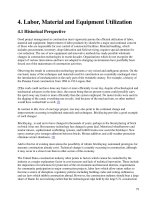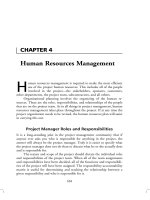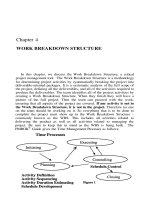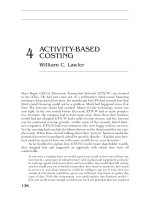bg management accounting chapter 4 3607
Bạn đang xem bản rút gọn của tài liệu. Xem và tải ngay bản đầy đủ của tài liệu tại đây (1.74 MB, 15 trang )
CHAPTER 4: Activity-Based Costing
4.1. Activity- Based Costing: An overview
4.2.Designing an Activity-Based Costing system
4.3. The limitation of Activity -Based Costing
4.1. Activity- Based Costing: An overview
Activity-based costing (ABC) is a costing method
that is designed to provide managers with cost information
for strategic and other decisions that potentially affect
capacity and therefore “fixed” as well as variable costs.
Most organizations that use activity-based costing have two
costing systems —the official costing system that is used for
preparing external financial reports and the activity-based costing
system that is used for managing activities.
4.1. Activity- Based Costing: An overview
In activity-based costing, many nonmanufacturing costs relate to
selling, distributing, and servicing specific products
First, ABC systems trace all direct nonmanufacturing costs to
products
Second, ABC systems allocate indirect nonmanufacturing costs to
products whenever the products have presumably caused the costs
to be incurred
4.1. Activity based costing – an overview
Manufacturing
costs
Nonmanufacturing
costs
Traditional
product costing
ABC
product costing
ABC assigns both types of costs to products.
4.1. Activity based costing – an overview
Traditional
product costing
some
All
Non manufacturing
costs
ABC
product costing
ABC does not assign all manufacturing costs to products.
4.1. Activity based costing – an overview
The most commonly used allocation base
in traditional costing is direct labor hours.
Direct labor hours work well when overhead increases
as direct labor hours increase.
Problems:
In many processes, overhead is increasing while direct
labor is decreasing.
Variety and complexity of products is increasing.
4.1. Activity based costing – an overview
An activity is any event that causes the consumption of overhead
resources.
An activity cost pool is a “bucket” in which costs are accumulated
that relate to a single activity measure in the ABC system.
An activity measure is an allocation base in an activity-based
costing system
A Cost driver is also used to refer to an activity measure because
the activity measure should “drive” the cost being allocated
Exh.
1-2
4.1. Activity based costing – an overview
ABC uses more allocation bases.
4.2. Designing an Activity-Based Costing
system
There are three essential characteristics of a successful activitybased costing implementation.
First, top managers must strongly support the ABC implementation
Second, top managers should ensure that ABC data is linked to how
people are evaluated and rewarded.
Third, a cross-functional team should be created to design
and implement the ABC system
4.2. Designing an Activity-Based Costing
system
Steps for Implementing ABC
Identify and define activities and activity cost pools.
Trace costs to activities and cost objects.
Assign costs to activity cost pools.
Calculate activity rates.
Assign costs to cost objects.
Prepare management reports.
4.2. Designing an Activity-Based Costing system
Unit-Level
Activity
Batch-Level
Activity
Manufacturing
companies typically combine
their activities into five
classifications.
Product-Level
Activity
Organizationsustaining
Activity
Customer-Level
Activity
4.2.Designing an Activity-Based Costing system
Activities
should only be
combined within a level
if they are highly
correlated.
When combining
activities, they should be
grouped together only at
the appropriate
level.
4.2. Designing an Activity-Based Costing system
An Activity Cost Pool is a “bucket” in which costs are
accumulated that relate to a single activity measure in the
ABC system.
Two types of activity measures:
Transaction
driver
Simple count
of the number of
times an activity
occurs.
Duration
driver
A measure
of the amount
of time needed
for an activity.
4.2. Designing an Activity-Based Costing system
Direct
Materials
Traced
Direct
Labor
Shipping
Costs
Traced
Traced
Cost Objects:
Products, Customer Orders, Customers
Overhead Costs
4.3. The limitation of Activity - Based Costing
Substantial resources
required to implement
and maintain.
Resistance to
unfamiliar numbers
and reports.
Desire to fully
allocate all costs
to products.
Potential
misinterpretation of
unfamiliar numbers.
Does not conform to
GAAP. Two costing
systems may be needed.









